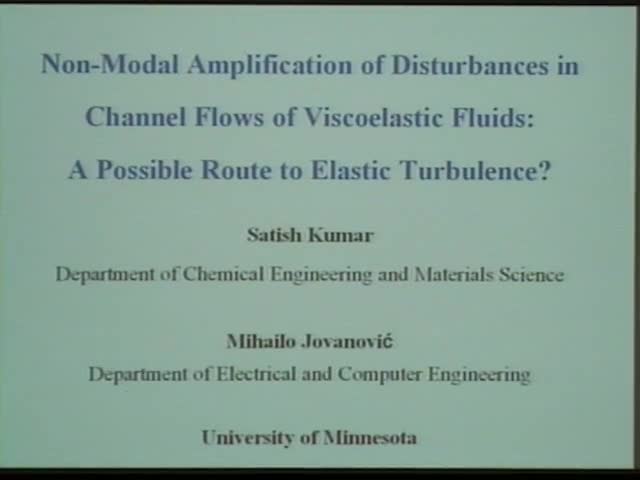Non-modal amplification of disturbances in channel flows of viscoelastic fluids: A possible route to elastic turbulence?
Presenter
October 12, 2009
Keywords:
- Viscoelastic fluids
MSC:
- 76A10
Abstract
This talk will provide an overview of our recent work on
amplification of disturbances in channel flows of
viscoelastic fluids. Even if a standard linear stability
(i.e., modal) analysis predicts that a particular flow is
stable, the question of the sensitivity of the flow to
various disturbances remains. If disturbances to the
linearized governing equations are sufficiently amplified
over a finite time interval, then nonlinearities may become
important and cause transition to a more complex flow state.
This can happen if the underlying linear operator is
non-normal, and represents a non-modal mechanism of
disturbance amplification. We address this issue by adopting
an input-output point of view borrowed from the systems- and
control-theory communities. The inputs to the linearized
equations consist of spatially distributed
and temporally varying body forces that are harmonic in the
streamwise and spanwise directions and stochastic in the
wall-normal
direction and in time. Such inputs enable the use of
powerful tools
from linear systems theory that have recently been applied to
analyze Newtonian fluid flows. We find that the most
amplified disturbances are three-dimensional in nature, and
that large amplification can occur under conditions of weak
inertia and strong elasticity. The underlying physical
mechanism involves polymer stretching that introduces an
effective lift-up of flow fluctuations similar to
vortex-tilting in inertia-dominated flows. The mechanism
examined here provides a possible route for a bypass
transition to elastic turbulence and might be exploited to
enhance mixing in microfluidic devices. (Joint work with
Mihailo Jovanovic, University of Minnesota.)
